1950s

1954
First maser demonstratedThe first maser is demonstrated
at Columbia University by Charles
Hard Townes, Herbert J. Zeiger and
James P. Gordon.
Lasers
1954
Optical Industry Directory published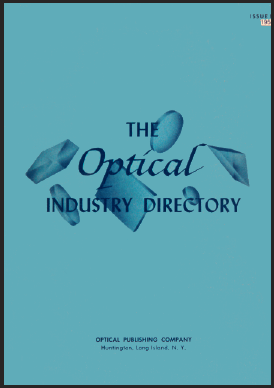
The Laurin Publishing/Photonics
Media story starts in 1954 with
the publication of the first Optical
Industry Directory by Dr. Clifton
Tuttle, eminent retired Eastman
Kodak physicist.
Current editionOptics1955
SPIE Founded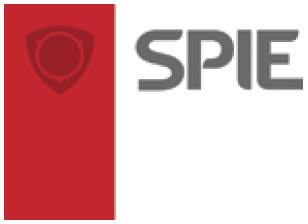
The Society of Photographic
Instrumentation Engineers (SPIE)
is founded.
More info >Optics1957
LASER acronym usedGordon Gould jots down the
acronym laser in a lab notebook
and has it notarized.
Lasers
1960s

1960
The 1960s - A brand new industry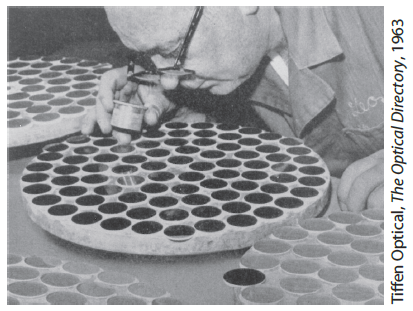
The 1960s gave shape to a brand
new industry and redefined our
world. The Baby Boom wound
down but left a legacy that would
be felt for decades to come – a
legacy that would challenge
this industry to solve problems
we were only then beginning to
understand.
Optics1960
Optical maser patent grantedTownes and Arthur L. Schawlow,
under Bell Labs, are granted a
patent for the optical maser.
Lasers
1960
First laser constructed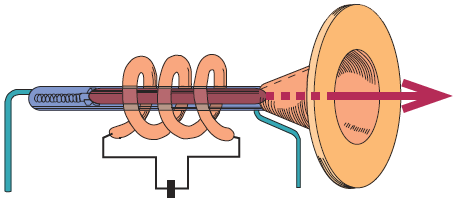
At Hughes Research Laboratories,
Theodore H. Maiman constructs
the first laser using a cylinder
of synthetic ruby.
Lasers1961
Lasers available commerciallyLasers appear on the commercial
market, offered by companies
including Trion Instruments,
PerkinElmer and Spectra-Physics.
Lasers
1961
First optical fiber laserElias Snitzer and colleagues at
American Optical build and
operate the first optical fiber laser.
Fiber
Lasers
1961
First medical laser useIn the first medical use of a laser on
a human patient, a ruby laser from
American Optical is used to destroy
a retinal tumor.
Lasers
1964
Nobel Prize in physics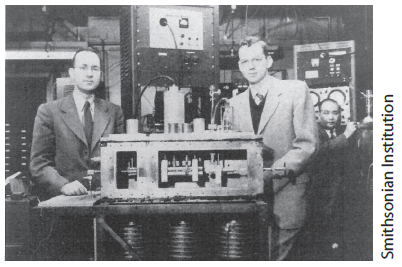
Townes, Nicolay Gennadiyevich
Basov and Aleksandr Mikhailovich
Prokhorov win the Nobel Prize in
physics “for fundamental work in
the field of quantum electronics,
which has led to the construction
of oscillators and amplifiers based
on the maser-laser principle.”
Lasers1966
Breakthrough in fiber opticsCharles K. Kao, working at Standard
Telecommunication Laboratories,
determines that fibers
of purest glass will allow better
transmission of light signals over a
distance of 100 km, compared with
glass fibers available at the time.
Fiber
1966
Nobel Prize in physicsAlfred Kastler is awarded the Nobel
Prize in physics ”for the discovery
and development of optical
methods for studying Hertzian
resonances in atoms.”
Optics
1967
Optical Spectra magazine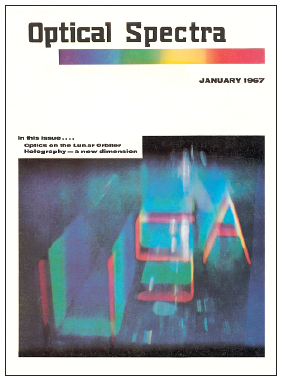
Teddi C. Laurin responds to
industry demand by publishing
Optical Spectra magazine.
See story, below right.
Photonics Spectra todayOptics1968
LIA founded
The Laser Industry Association
is founded.
More info >Lasers1969
Color video cartridge playerRCA introduces a color video cartridge
player called SelectaVision
that uses laser technology and holographic
images to produce full-color
pictures on a standard home TV.
Displays
1969
Photonics industry expanding
As shown by the maps here from
the 1969 edition of the Optical Industry Directory (now the Photonics Buyers' Guide),
the US industry reflects a shift
toward the western states. While it
is not seen here, the global reach
of the photonics industry now
includes companies in Japan,
Pakistan, Australia, New Zealand,
the Philippines and Israel.
A total of 1931 companies are
represented.
1970s

1970
The 1970s - Photonics as a separate technologyThe idea of photonics as a separate
technology was built throughout
the decade, and researchers
explored the use of photonic
principles in applications ranging
from imaging to communications.
The average Optical Spectra reader
was employed by private industry,
was an engineer or a scientist with
an advanced degree, was under
40 years of age, and was earning
$14,000-$25,000 with a company
he had been with for less than five
years. He majored in physics or electrical
engineering in undergraduate
school. (Optical Spectra, May 1970)
1970
Continuous-wave room-temperature semiconductor lasersResearchers at Ioffe Physico-
Technical Institute and Bell Labs
produce the first continuous-wave
room-temperature semiconductor
lasers, paving the way to commercialization
of fiber optics communications.
Fiber
Lasers
1972
Nobel Prize in physics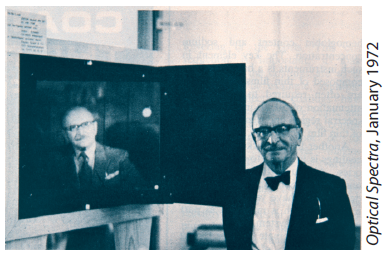
Dennis Gabor is awarded the
Nobel Prize in physics “for his
invention and development of the
holographic method.” Gabor tells
Optical Spectra that, “As far as we
can see, the great technologies will
come from coherent optics – that’s
pretty certain. I should also say that
the big advances we can expect
with reasonable certainty will take
place in optical processing, with
computers.”
Optics1973
La Photonique coinedThe term “La Photonique” is coined by a French physicist to describe
the use of photons in ways analogous to the use of electrons.
1974
First bar-codesA pack of Wrigley’s chewing gum
is the first product read by a barcode
scanner in a grocery store.
Lasers
1976
Predicted success of coherent opticsH.J. Caulfield of Block Engineering
tells Optical Spectra, “The success of
coherent optics lies in the demonstration
of its advantages over incoherent
optics or digital techniques,
and the necessity for its innovative
methods in biology and medicine.”
Optics
1977
A star is born - Optical communications“The birth of a new technology
is always an exciting event. It is
particularly so in the case of optical
communications, an enormously
promising technology that has
been waiting in the wings for more
than a decade and is now moving
onstage with a burst of activity that
bids fair to revolutionize the telecommunications
field. ... [As major
telecommunications providers]
almost simultaneously move a new
technology from the laboratory to
the marketplace, one needn’t doubt
that it is an idea whose time has
come.”
– Teddi C. Laurin, Optical Spectra,
July 1977
Fiber
Optics
1977
Underground fiber opticsA 1.5-mile underground fiber optic
transmission system links Illinois Bell
central offices and customers across
three buildings.
Fiber
1979
Cascading solar cell conceptResearch Triangle Institute, in
cooperation with North Carolina
State University, reports a major
step in proving the cascading solar
cell concept, which could mean
photovoltaic solar-to-electric
conversion efficiencies above
30 percent.
Solar
1979
Email will failThat electronic mail thing will never take off!
From the July 1979 Photonics Spectra: “Battelle researchers have reported that there
are a number of obstacles to the future use of electronic mail – the generation,
transmission, storage, disposition and display of business correspondence and
documentation by electronic means. The greatest of these barriers is the unwillingness
of managers to use the electronic mail systems directly, without going through
secretaries, according to Richard J. Bengston, head of the Battelle study.”
1980s

1980
New era in communications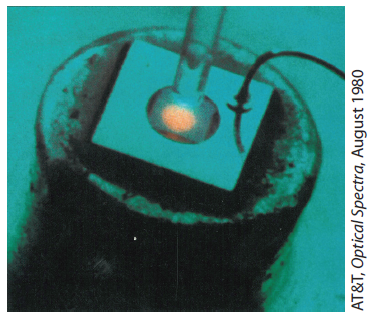
In 1980, telecommunications was
getting some attention in Optical
Spectra, including the double-heterostructure
light-emitting diode
that operated at 1300 nm. It was
equipped with a microlens that
improved coupling with the optical
fiber, from AT&T. The breakup of
AT&T launched a new era in communications,
with fiber optics at its
core. National laboratories in the
US and abroad applied laser technology
to the alternative energy
problem.
FiberLasers1980
Charles Hard Townes AwardThe Charles Hard Townes Award
is established by OSA to recognize
“outstanding experimental or theoretical
work, discovery or invention
in the field of quantum electronics.”
Lasers
1981
NobelPrize in physicsNicolaas Bloembergen and Arthur
Leonard Schawlow win the Nobel
Prize in physics “for their contribution
to the development of laser
spectroscopy.”
Lasers
Spectroscopy
1982
Photonics Spectra magazine1982
Worldwide PV productionWorldwide PV production exceeded 9.3 MW.
Solar
1982
First audio CDThe audio CD, a spinoff of Laser-
Disc video technology, debuts.
Billy Joel fans rejoice as his 1978
album, “52nd Street,” is the first to
be released on CD.
Lasers
1982
Improved LCD CellsNorsk LCD A/S of Norway reports
that it can produce LCD cells measuring
up to 30 x 30 cm with a proprietary
manufacturing technique.
Displays
1984
Surge in CAD/CAMThe market for high-resolution
color graphics displays is on the
upswing, thanks to a surge in the
sales of computer-aided design
and manufacturing (CAD/CAM)
systems.
Displays
1986
Improved lenses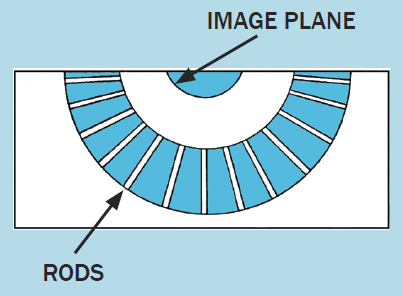
Robert Zinter, a graduate student
at the University of Rochester
Institute of Optics, borrows from
the fly’s compound eye to make an
optical device consisting of a series
of glass rods that produce wideangle
views without the distortion
inherent in conventional wideangle
lenses.
Optics1986
Nobel Prize in physicsGerd Binnig and Heinrich Rohrer
are awarded the Nobel Prize in
physics “for their design of the
scanning tunneling microscope.”
Microscopy
1986
Nobel Prize in physicsErnst Ruska is awarded the Nobel
Prize in physics “for his fundamental
work in electron optics, and
for the design of the first electron
microscope.”
Microscopy
Optics
1989
Improved solar-to-electric conversionResearchers at Sandia National
Laboratories achieve solar-to-electric
conversion of 20.3 percent.
Solar
1990s

1990
Maturing optics & laser technology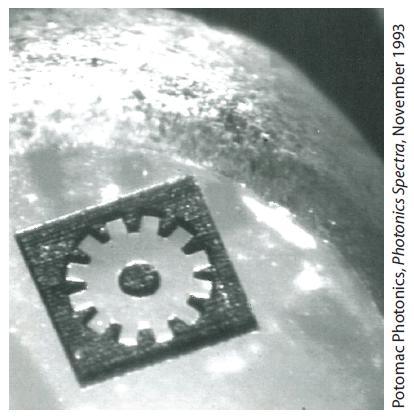
R&D budgets shrank, solid-state
technology came on strong, and we
put the pedal to the metal on the
Information Superhighway. Optics
and laser technology had reportedly
reached a level of maturity
similar to that of electronics in the
late 1940s and early 1950s. In an
editorial, Teddi Laurin wrote: “The
impact of photonics is only beginning
to be felt.” The image below is
a miniature gear structure formed
in the surface of a polished type Ib
diamond substrate by 248-nm laser
ablation.
LasersOptics1990
Expanding reach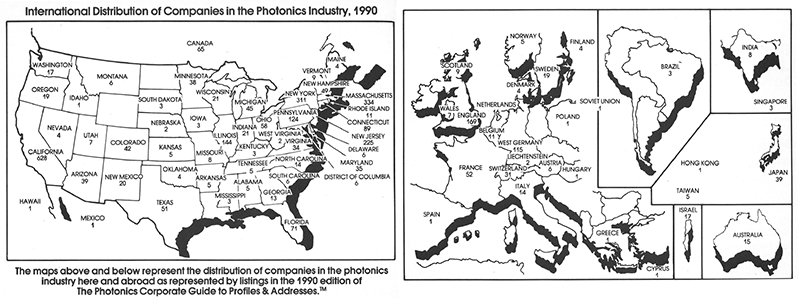
As shown by the maps here from the 1990 edition of the Directory, the global
reach of the photonics industry includes companies in Japan, India, Australia,
South America and Israel.
A total of 3178 companies are represented.
1991
Erbium-doped fiber amplifier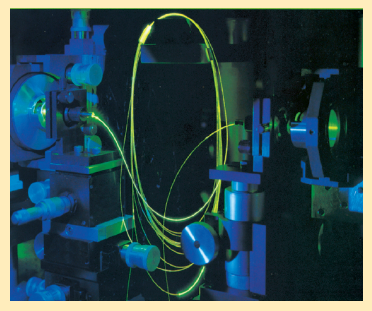
The image below of an erbium-doped
fiber amplifier, pumped
by an argon laser, appears in
Photonics Spectra, courtesy of
GTE Laboratories.
Fiber1994
Quantum cascade laserThe first quantum cascade laser
(QCL) is invented at Bell Labs by
Jerome Faist, Federico Capasso,
Deborah L. Sivco, Carlo Sirtori,
Albert L. Hutchinson and Alfred Y. Cho.
Lasers
1994
New generation of technologyA new generation of photonic
technologies for process and quality
control includes holographic
inspection techniques, photontunneling
microscopy and the use
of narrowband tunable diode lasers
in spectroscopy.
Lasers
Microscopy
Spectroscopy
1994
BioPhotonics magazine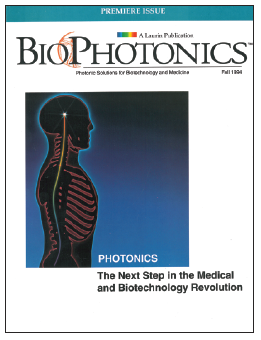
BioPhotonics magazine is
launched by Laurin Publishing/
Photonics Media.
BioPhotonics today1996
Optical fibers improveAs optical fibers improve, various
sensing techniques appear in
manufacturing applications.
Fiber
1996
EuroPhotonics magazine1997
Airborne Laser systemThe US Air Force approves a $1.1
billion antiballistic Airborne Laser
system. Boeing, TRW and Lockheed
Martin will build the 747-based
system, which will use a highenergy
chemical oxygen iodine
laser (COIL).
Lasers
1997
Low-cost digital displayIn response to increasing demands
for higher information content and
higher resolution in ever-smaller
spaces, Silicon Light Machines
develops a low-cost, reflective and
entirely digital display based on
grating light valve technology.
Displays
1998
Nobel Prize in physicsSteven Chu, Claude Cohen-
Tannoudgji and William D. Phillips
are awarded the Nobel Prize in
physics “for development of
methods to cool and trap atoms
with laser light.”
Lasers
1998
Increasing instruments marketThe instruments market, including
UV and visible spectrophotometers
and spectrometers, is expected
to grow to $170 million by 2003,
riding spectroscopy’s move from
the lab to the production floor,
according to Business Communications
Inc.
Spectroscopy
1999
Photovoltaics predictionIndustry experts predict that by
the mid-21st century, photovoltaics
will expand into the energy
mainstream.
Solar
2000s

2000
New millenniumA new millennium – or maybe not –
brought with it fears of the Y2K
bug. Ultimately, it was not the end
of the world as we knew it, but the
bursting of the dot-com bubble a
short time later sure felt like it.
Military innovation, medical advances
and basic research continued
to find new opportunity in
photonic technologies.
2002
Improved sunlight to electrical currentResearchers at Lawrence Berkeley
National Laboratory’s Materials
Sciences Div. discover a 0.7-eV
bandgap of the semiconductor
indium nitride. The finding shows
that a single system of alloys
incorporating indium, gallium
and nitrogen can convert virtually
the full spectrum of sunlight to
electrical current.
Solar
2003
European Photonics Industry Consortium
The European Photonics Industry
Consortium is founded by companies
Aixtron, CDT, Osram,
Philips and Sagem.
2003
Nanostructured sample holder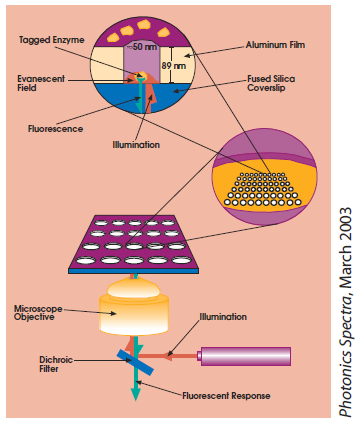
A nanostructured sample holder
developed at Cornell University
incorporates nanoholes that act as
zero-mode waveguides, enabling
the analysis of single molecules at
more realistic concentrations.
Microscopy2005
Nobel Prize in physicsRoy J. Glauber is awarded the
Nobel Prize in physics “for his contribution
to the quantum theory of
optical coherence.”
Optics
2005
Nobel Prize in physicsJohn L. Hall and Theodor W. Hänsch
are awarded the Nobel Prize in physics
“for their contributions to the
development of laser-based precision
spectroscopy, including the
optical frequency comb technique.”
Lasers
Spectroscopy
2006
OLED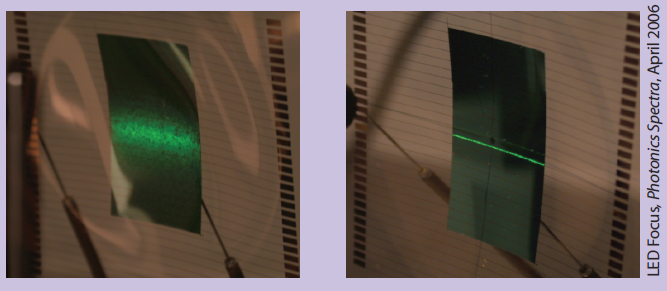
Researchers at Princeton University and at Universal Display Corp. construct
a flexible organic LED (OLED) on a flat 9.5 3 9.5-cm sheet of plastic and deform
it into a dome with a radius of 8.5 cm.
Displays2007
LED illumination predictionLED illumination is predicted to
become a mainstream light source.
2007
Silicon Photonics AllianceThe Optoelectronics Industry
Development Association (OIDA)
forms the Silicon Photonics Alliance
(SPA) to focus on market and
business issues on behalf of its
members who are engaged in the
technology.
Optics
2008
Brain cell research grantStanford University researcher
Dr. Karl Deisseroth receives a $1.5
million science and engineering
grant from the W.M. Keck Foundation
to advance his research on
controlling brain cells with pulses
of light.
2009
Nobel Prize in physicsCharles Kuen Kao is awarded onehalf
of the Nobel Prize in physics
“for groundbreaking achievements
concerning the transmission of
light in fibers for optical communication.”
The other half was shared
jointly by William S. Boyle and
George E. Smith “for the invention
of an imaging semiconductor
circuit – the CCD sensor.”
Fiber
Imaging
2010s

2010
THz photonic integrated circuitBy integrating a terahertz quantumcascade
laser and diode mixer into
a monolithic solid-state transceiver,
researchers at Sandia National
Laboratories successfully form a
terahertz (THz) photonic integrated
circuit that can provide improved
control of the underutilized THz
frequency.
Lasers
2010
IEEE Photonics Award
Ivan P. Kaminow is awarded the IEEE
Photonics Award “for seminal contributions
to electro-optic modulation,
integrated optics and semiconductor
lasers, and leadership in optical
telecommunications.”
More info >LasersOptics2011
40-Gb/s optical modulatorMembers of the Helios project in
Europe demonstrate for the first
time a 40-Gb/s optical modulator
in silicon with a record extinction
ratio of 10 dB, accomplishing a key
project goal needed to build and
optimize the entire supply chain
for fabricating complex functional
silicon-based photonic devices.
Optics
2012
192-beam laser system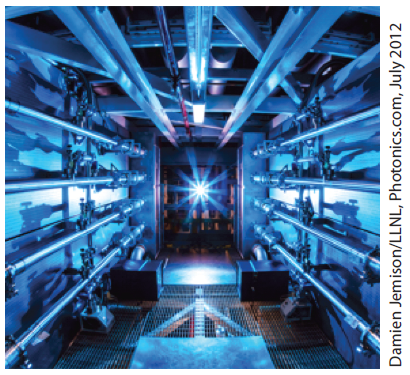
The National Ignition Facility’s
(NIF’s) 192-beam laser system delivers
a record-breaking 500 TW of
peak power and 1.85 MJ of UV laser
light to its target, validating the
NIF’s laser performance specifications
set in the late 1990s.
Lasers2012
Nonionizing near-IR spectroscopyNonionizing near-IR spectroscopy
for brain imaging has found widespread
application, especially with
infants, the elderly or any patients
who can’t easily be moved onto a
scanner.
Imaging
Spectroscopy
2013
CLARITYCLARITY (clear lipid-exchanged
acrylamide-hybridized rigid
imaging/immunostaining/in situ
hybridization-compatible tissuehydrogel),
a technique developed
by Dr. Karl Deisseroth and a multidisciplinary
team at Stanford University,
yields a 3-D transparent
brain with all of its important
structures intact and in place.
Imaging
2013
STPV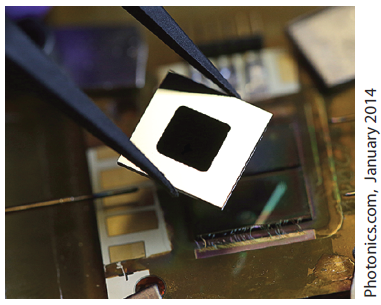
A nanophotonic solar thermophotovoltaic
(STPV) device from MIT
combines PV and solar thermal
systems to allow thermal energy
storage.
Solar2013
National Photonics Initiative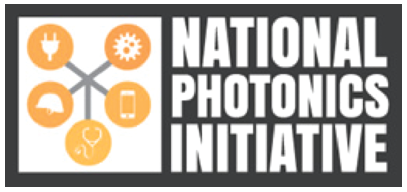
The National Photonics Initiative (NPI)
– an alliance seeking to unite experts
from industry, academia and the government
to advance photonics R&D,
grow the US economy and improve
national security – is launched in late
May by a partnership of photonics societies:
The American Physical Society,
IEEE Photonics Society, Laser Institute
of America (LIA), The Optical Society
(OSA) and SPIE.
2013
Curiosity Rover lands on Mars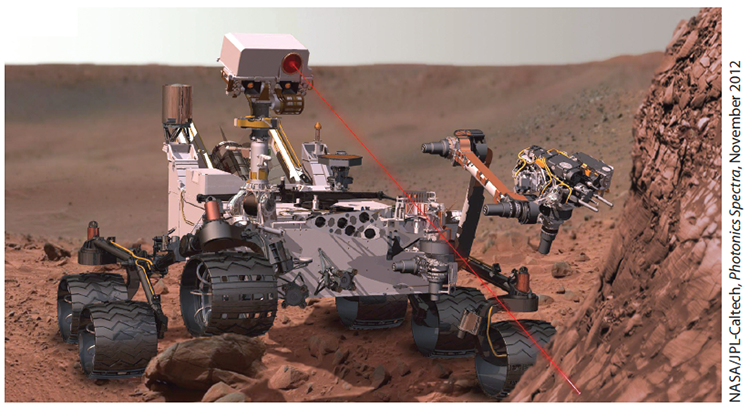
NASA’s Curiousity Rover lands on Mars in May and by early December,
the laser instrument on board has surpassed 100,000 shots. Designed
to fire 1 million shots, the ChemCam zaps rocks and dust with a highpower
laser to determine their composition.
Lasers2013
Bottle resonatorResearchers at Vienna University
of Technology’s Vienna Center for
Quantum Science and Technology
demonstrate a fiber optic switch
that uses a novel type of silica
WGM known as a “bottle resonator.”
The demonstration shows
that a single atom can direct light
from one fiber optic cable to a
second one.
Fiber
2013
First QD-based displayThe Sony Triluminous HDTV
becomes the first quantum dot
(QD)–based display. It features
excellent color purity provided
by the QDs, near-unity emission
quantum yields and narrow
emission bands.
Displays
2014
More efficient solar energyA team at MIT discovers a way to
harvest solar energy more efficiently
and potentially on demand.
The new solar thermophotovoltaic
(STPV) device combines photovoltaic
(PV) systems, which turn
sunlight directly into electricity,
and solar thermal systems, which
allow delayed use of energy, since
heat can be stored more easily
than electricity. While previous
experiments have been unable to
produce an STPV device with an
efficiency of greater than 1 percent,
this new device shows a measured
efficiency of 3.2 percent. With further
work, the team says, it could
reach 20 percent efficiency.
Solar
2014
Optical add-on kitsOptical add-on kits convert everyday
consumer electronics into
scientific devices. Today you can
turn your iPad into a spectrometer.
Optics
2014
SWARPESThe hidden junctures where different
layers of materials meet could
become less mysterious under a
spectroscopy technique developed
using the Advanced Light
Source (ALS) at Lawrence Berkeley
National Laboratory. SWARPES, for
Standing Wave Angle-Resolved
Photoemission Spectroscopy, allows
the selective study of buried
interfaces between layers of metal
oxides in nanotechnology with
either soft or hard x-rays.
Spectroscopy
2014
Increased global distribution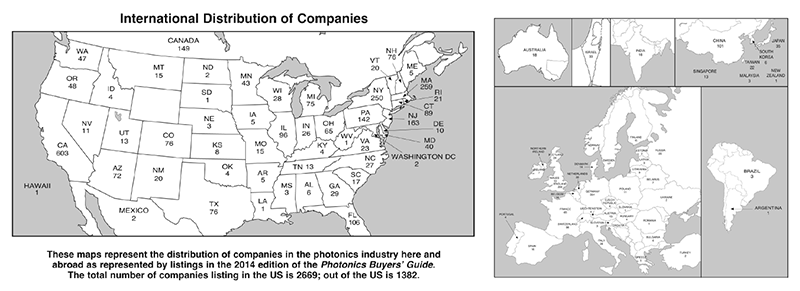
As shown by this map from the 2014 edition of the Photonics Buyers’ Guide, the global
reach of the photonics industry now includes companies in China, South Korea and
numerous countries throughout Europe.
A total of 4051 companies are represented.
2016
First silicon photonics modulesIntel debuts silicon photonics modules for fast connectivity in data centers.
Optics
2018
Nobel Prize in physicsDonna Strickland and Gérard Mourou are awarded half the Nobel Prize in physics for the chirped pulse laser. Arthur Ashkin is awarded the other half for the invention of optical tweezers.
Lasers
2019
Quantum supremacyGoogle claims that its Sycamore processor achieves quantum supremacy.
2020s
2020
Nobel Prize in physicsLaureates Roger Penrose, Reinhard Genzel, and Andrea Ghez were recognized with the 2020 Nobel Prize in physics. Genzel and Ghaz used adaptive optics and infrared speckle imaging techniques in the work that would ultimately lead to the award.